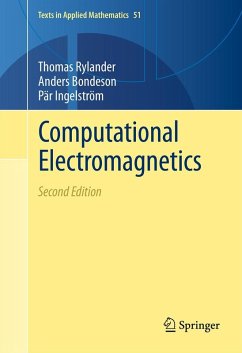Computational Electromagnetics is a young and growing discipline, expanding as a result of the steadily increasing demand for software for the design and analysis of electrical devices. This book introduces three of the most popular numerical methods for simulating electromagnetic fields: the finite difference method, the finite element method and the method of moments. In particular it focuses on how these methods are used to obtain valid approximations to the solutions of Maxwell's equations, using, for example, "staggered grids" and "edge elements." The main goal of the book is to make the reader aware of different sources of errors in numerical computations, and also to provide the tools for assessing the accuracy of numerical methods and their solutions. To reach this goal, convergence analysis, extrapolation, von Neumann stability analysis, and dispersion analysis are introduced and used frequently throughout the book. Another major goal of the book is to provide students
with enough practical understanding of the methods so they are able to write simple programs on their own. To achieve this, the book contains several MATLAB programs and detailed description of practical issues such as assembly of finite element matrices and handling of unstructured meshes. Finally, the book summarizes the strengths and weaknessesof the different methods to help the student decide which method may be best for each problem.
In this second edition the book was updated throughout and extensive computer projects are included.
Reviews of previous edition:
"This well-written monograph is devoted to students at theundergraduate
level, but is also useful for practising engineers." (Zentralblatt MATH, 2007)
with enough practical understanding of the methods so they are able to write simple programs on their own. To achieve this, the book contains several MATLAB programs and detailed description of practical issues such as assembly of finite element matrices and handling of unstructured meshes. Finally, the book summarizes the strengths and weaknessesof the different methods to help the student decide which method may be best for each problem.
In this second edition the book was updated throughout and extensive computer projects are included.
Reviews of previous edition:
"This well-written monograph is devoted to students at theundergraduate
level, but is also useful for practising engineers." (Zentralblatt MATH, 2007)
Dieser Download kann aus rechtlichen Gründen nur mit Rechnungsadresse in A, B, BG, CY, CZ, D, DK, EW, E, FIN, F, GR, HR, H, IRL, I, LT, L, LR, M, NL, PL, P, R, S, SLO, SK ausgeliefert werden.
From the reviews of the second edition:
"The book under review is an introductory textbook on CEM targeted at undergraduate students. The aim of the book is to introduce some popular and powerful CEM algorithms. ... this is a well-written and lucid textbook for students and researchers interested in learning CEM. Readers can enhance their knowledge of CEM with the Summary, Review Questions, Problems, and Computer Projects sections presented in most chapters." (JiChun Li, Mathematical Reviews, June, 2013)
"The book under review is an introductory textbook on CEM targeted at undergraduate students. The aim of the book is to introduce some popular and powerful CEM algorithms. ... this is a well-written and lucid textbook for students and researchers interested in learning CEM. Readers can enhance their knowledge of CEM with the Summary, Review Questions, Problems, and Computer Projects sections presented in most chapters." (JiChun Li, Mathematical Reviews, June, 2013)


